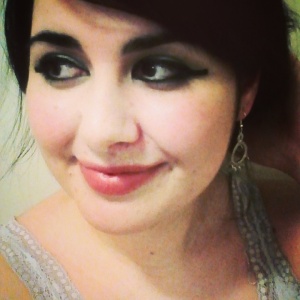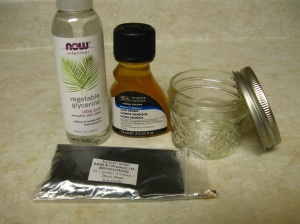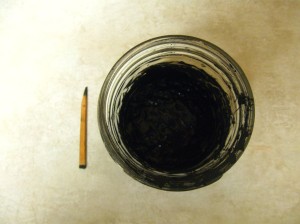
Not only were cosmetics used in Ancient Egypt, but they were considered to be so important that they were among the few items buried with the dead for use in the afterlife. The Egyptians were remarkably advanced and along with face masks and exfoliants, they also had effective anti-aging cream made from frankincense (an anti-inflammatory) and puncture tattooing not unlike what we use today. Perhaps the most famous of Egypt’s contributions to beauty, however, is eyeliner.
Eyeliner, or “kohls,” were worn by men, women, and children of all social classes. They were black or green, and made from galena (ore of lead) or malachite (green ore of copper) mixed with oil and applied with wood or ivory. Kohls were believed to have healing properties by invoking the protection of Ra and Horus, and may have actually worked to prevent disease. Eye infections were common when the Nile flooded, but the lead-based makeup was so toxic that it killed infection before it could reach the eye. In addition to its antibacterial properties, the copper ions in the malachite protected the eyes from sunburn.
Although eyeliner was very common, today we probably most associate this iconic style with Cleopatra, a woman of such legendary sex appeal she is still very much a presence in popular culture today. Plutarch tells us that she was not exactly a beauty, but her presence and charm made her irresistible. Goodness knows it would take both to win over both Julius Caesar and Mark Antony and pass yourself off as the reincarnation of the goddess Isis. She had mad language skills (speaking at least nine languages), a signature scent (henna oil), and wicked awesome eyeliner.
This Halloween, why not have a little fun with history and make some Egyptian eyeliner? Whether you’re rolling yourself in a carpet to seduce a foreign dignitary or just passing out candy to trick-or-treaters, give yourself a little ancient world smolder with this modernized recipe developed from Sally Pointer’s in her magnificent The Artifice of Beauty.
Fortunately for us, this recipe does not include lead or anything known to be toxic. Before applying anything to your face, please do a patch test on your arm in case you are sensitive to any of the ingredients. You don’t want to mess around with your eyes!
2 teaspoons of cosmetic grade black iron oxide
1 milliliter of liquid gum arabic*
.5 milliliter of vegetable glycerin
.5 milliliter of boiled water, cooled
Small sterile jar
Mix the gum arabic and glycerin into the iron oxide powder, then add water a drop at a time until the mixture turns into a smooth, thick paste. You can apply it immediately or allow it to set.
*Pointer’s recipe uses ½ teaspoon of powdered gum arabic, but I could not find this so I substituted the liquid version.
The Egyptians applied this with ivory or wood, so I used a toothpick (pictured) because I’m difficult. You will probably get better results using an eyeliner brush. I used the toothpick to stipple the liner all around my eyes, and extended the line with the wider end of the pick. This liner is as easy to rub off as put on, so it’s more effective to build it up slowly, allowing it to dry as you go. It dries quickly and the color is very dark. It wears surprisingly well, but will flake easily if you rub it. Mercifully, it is very water-soluble and will come off will come off with soap and water.
 In addition to the eyeliner, I am also wearing a dark green eye shadow the color of malachite (pictured right). Although depictions of Cleopatra often show her wearing a bright, peacock blue color on her eyes, malachite is actually a vibrant emerald green.
In addition to the eyeliner, I am also wearing a dark green eye shadow the color of malachite (pictured right). Although depictions of Cleopatra often show her wearing a bright, peacock blue color on her eyes, malachite is actually a vibrant emerald green.
I ordered the iron oxide for this recipe off of Amazon, thinking I could find the other ingredients easily enough around town. Unfortunately, gum arabic is not that easy to track down. After trying several stores, I found some liquid gum arabic in the watercolor paint section of Michael’s. I used vegetable glycerin I found in the skin care section of Whole Foods. All of the ingredients can be found easily online if you have time to order them.
Verdict
If you don’t happen to have the ingredients lying around, this project might be on the expensive side. The iron oxide was about $13 with shipping, the gum arabic $17, and the glycerin $7. For $40, you could walk into Sephora and buy pretty much any eyeliner(s) you’d like that would deliver similar results and last longer. This is not very cost-effective, but if you want to know what it’s like to fix your own kohl paste and how it feels drying on your face (for research or just curiosity), it’s a fun way to spend an afternoon.
Jessica Cale
Sources
Bhanoo, Sindya N. “Ancient Egypt’s Toxic Makeup Fought Infection, Researchers Say”. The New York Times.
Lucas, A. Cosmetics, Perfume, and Incense in Ancient Egypt.
Pointer, Sally, The Artifice of Beauty.



Jess, I really love your blog. This was so interesting. You always have amazing facts. Thank you. Also, thank you for giving a free copy of Tyburn to your subscribers. I am enjoying it immensely. I will be buying Mark’s story. Happy Writing.
LikeLike
Tricia, I cannot tell you how happy it makes me that you’re enjoying the blog and Tyburn as well. Thank you so much! I hope you like Mark’s story as much as I enjoyed writing it. That man does leave an impression! LOL Thank you for your lovely comment and I hope you’re having a wonderful weekend. xx
LikeLiked by 1 person
Fabulous! Simply fabulous!
LikeLike
Thank you, Hunter! ❤
LikeLiked by 1 person
[…] Cleopatra’s Eyeliner (Recipe) […]
LikeLike